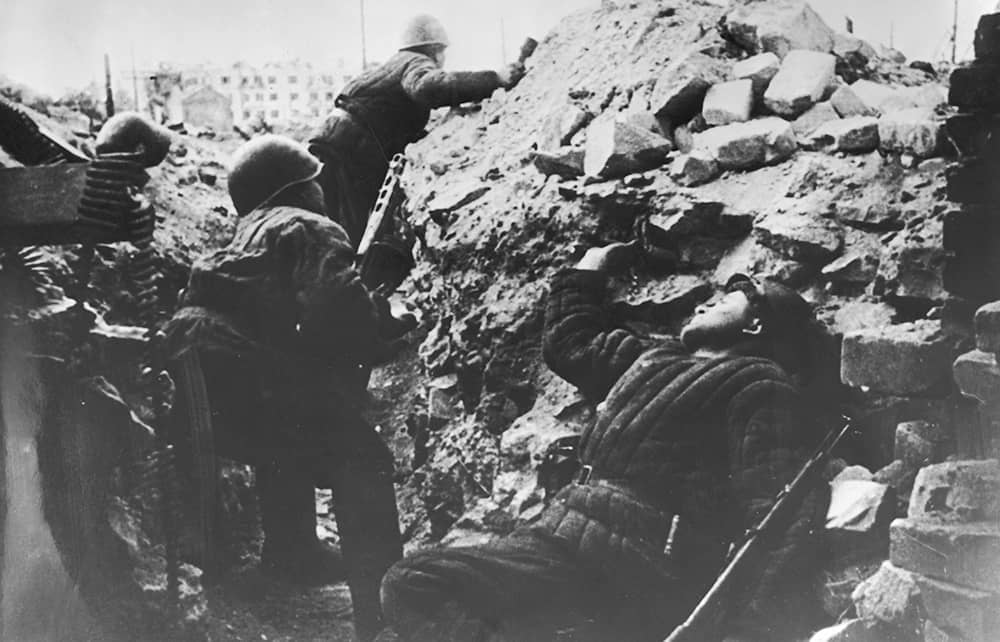Sometimes the struggle for a single small strongpoint can tip the whole balance of a greater battle. One thinks of the closing of the gates of Hougoumont farm at Waterloo, or the bloodless German seizure of Fort Douaumont at Verdun – an error it took an estimated 100,000 French lives to reverse. According to Iain MacGregor, this role at Stalingrad was played by a non-descript four-storey building in the city’s central district, codenamed ‘the Lighthouse’, but subsequently known as ‘Pavlov’s House’, after one of its garrison’s leaders, Sergeant Yakov Pavlov.
MacGregor’s meticulously researched narrative of the titanic battle that was the turning point of the second world war focuses on the epic two-month struggle for possession of this single structure between its Russian defenders and German attackers.
The dogged siege of the building – with much help from Soviet propaganda after it was eulogised in the army newspaper Stalin’s Banner – became emblematic of the wider battle that would represent the shattering of Hitler’s hopes of triumphal conquest and the beginning of his downfall.
So many of the features of the fighting at Stalingrad – the rattenkrieg hand-to-hand tussle waged for cellars that repeatedly changed hands, or for mounds of shell-pounded rubble that had been tenement blocks – were reproduced in miniature in the ding-dong struggle for the Lighthouse. Surrounded by the Germans on three sides, the house’s beleaguered defenders – stranded women civilians as well as soldiers – hung on grimly, knowing that if they lost it, the whole of Stalingrad could fall with it, allowing Hitler to claim a famous victory in the city that bore his rival dictator’s name.
The Lighthouse owed its importance to its strategic position. Sited on the 9th January Square on the banks of the Volga, it was one of the last toeholds in the city retained by the Red Army on the vast river’s western bank. While the Wehrmacht wasted precious time and resources trying to take it and other stubborn redoubts, Marshal Vasily Chuikov built up his forces around the city until he was ready to snap the jaws of his encirclement shut, trapping General Paulus’s Sixth Army in the Kessel (cauldron) that would become their tomb.
MacGregor is fair to both sides, and gives a starring role to General Friedrich Roske, an officer barely mentioned by Antony Beevor in his celebrated study of the battle. MacGregor credits him with having negotiated Paulus’s surrender when the newly promoted field marshal was holed up in his HQ in the Univermag department store in a state of nervous collapse. After the capitulation, Roske spent years in the gulag and only returned to Germany in 1955, committing suicide a few months later.
The book is very much a worm’s-eye view of this brutal battle. In contrast to Beevor, who is good on the higher strategy, MacGregor takes us right into the war on and below the ground, devoting comparatively little space, for example, to the squabbles Hitler and Stalin had with their generals, and none at all to what became of the German commanders captured after the battle, when some, like Paulus himself, turned traitor and became Stalinist puppets while others stayed loyal to the Führer and suffered the consequences.
But the author does go over the top in praising Chuikov, seeing him in almost Soviet terms as the stainless architect of victory and the very model of a modern comrade general: ‘He was beloved… a man who knew his place in the Great Patriotic War… he ensured that he would be chief among equals when it came to celebrate his country’s greatest victory.’
Indeed my main quibble is with the starry-eyed way in which MacGregor writes of the heroism of the Red Army and of those responsible for the hard-fought victory over Hitler. They were ‘unsung heroes… who had performed superhuman heroics’. No doubt there were many such men who fought at Stalingrad, but the book makes no mention of Lavrenti Beria, Stalin’s sinister secret police chief, waiting behind the lines with his NKVD killers to shoot anyone who flinched and fled.
This is a gripping and knowledgeable account, but some of the Russophile purple passages might have been lifted straight from Pravda in 1942. It’s not the author’s fault, of course, but at a time when Russian soldiers are better known for rape, torture and unprovoked aggression than for the uncomplicated heroics recounted here, the book’s publication could hardly have been worse timed.






Comments